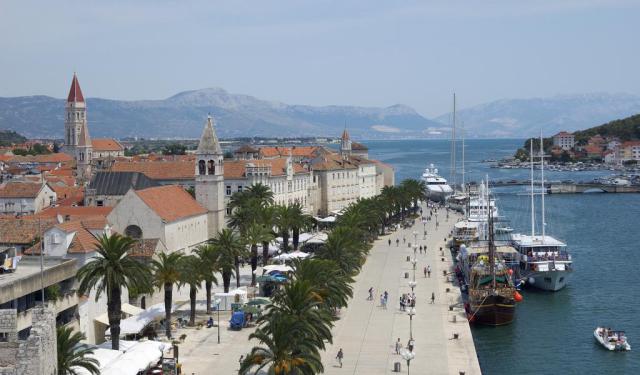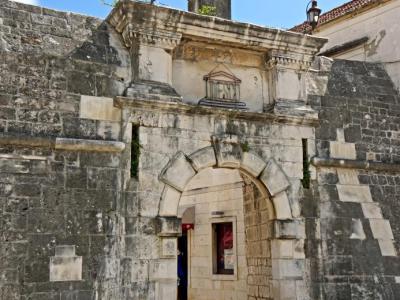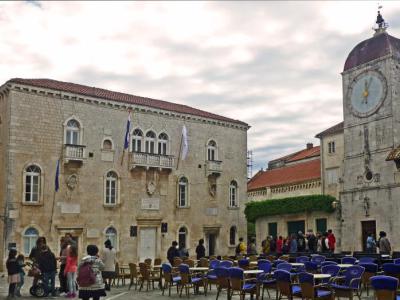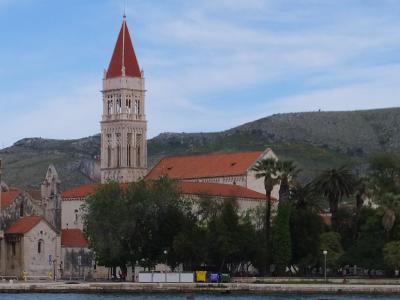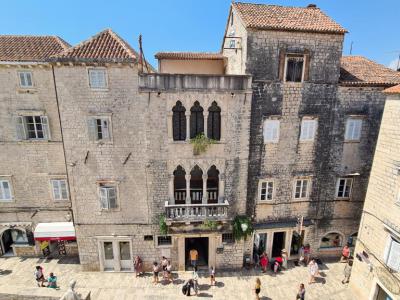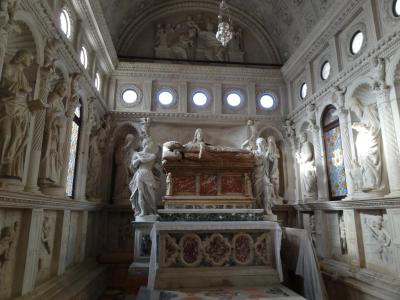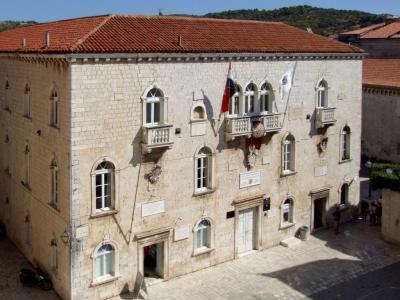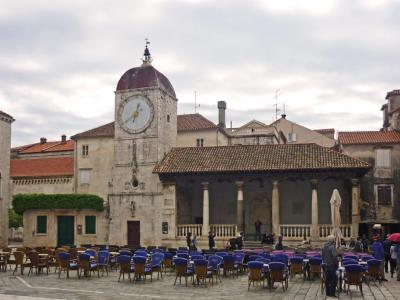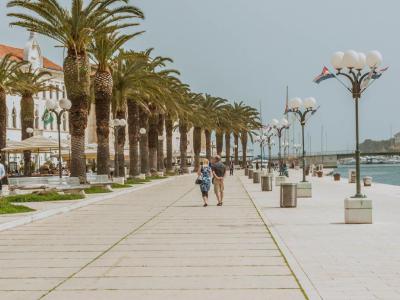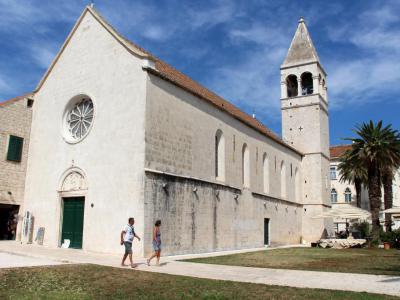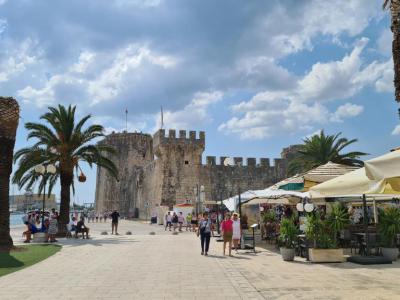Trogir Introduction Walking Tour (Self Guided), Trogir
Trogir, a charming small town on the scenic Dalmatian coast of Croatia, boasts 2300 years of continuous urban tradition. Established in the 3rd century BC, throughout its history the town has been influenced by the ancient Greeks, Romans, and Venetians, to mention but a few.
Originally known as Tragurion, its name is derived from the Greek words "tragos" (male goat) and "oros" (hill or mountain), possibly referencing the local landscape. Trogir served as a major port until the Roman period but later faced a decline in prominence.
From the 9th century on, the town paid tribute to Croatian rulers and the Byzantine Empire. In the year 1000, it submitted to the Republic of Venice, which led to cultural and economic exchanges. However, in 1105, Trogir acknowledged Hungarian supremacy while retaining its municipal freedom.
In 1123, the town faced devastation at the hands of the Saracens but quickly recovered and thrived economically in the 12th and 13th centuries under Venetian influence. Venetian long-term rule began in 1420, lasting nearly four centuries and bringing prosperity to the area, as evidenced by its Renaissance art and architecture.
Trogir became a part of the Habsburg Empire in 1797 and later experienced various rulers during World Wars I and II. It ultimately became part of independent Croatia in 1991.
Trogir is tiny in size. You can stroll the entire town in well under an hour. Begin your journey in the Main Square, whose lively atmosphere provides a perfect starting point to explore Trogir's rich heritage.
Dominating the town's skyline is the Trogir Cathedral, a UNESCO World Heritage site known for its stunning Romanesque and Gothic architecture. Climb the Bell Tower for panoramic views of the town and surrounding islands.
Stroll along the picturesque Waterfront Promenade, offering breathtaking views of the Adriatic Sea and a chance to enjoy delicious local cuisine.
Explore the imposing Kamerlengo Castle, originally built as a fortress and now a venue for cultural events and exhibitions.
For those seeking an enchanting blend of architectural marvels, captivating history, and stunning coastal views, Trogir offers an unforgettable experience – an invitation to step back in time while enjoying the beauty of the present!
Originally known as Tragurion, its name is derived from the Greek words "tragos" (male goat) and "oros" (hill or mountain), possibly referencing the local landscape. Trogir served as a major port until the Roman period but later faced a decline in prominence.
From the 9th century on, the town paid tribute to Croatian rulers and the Byzantine Empire. In the year 1000, it submitted to the Republic of Venice, which led to cultural and economic exchanges. However, in 1105, Trogir acknowledged Hungarian supremacy while retaining its municipal freedom.
In 1123, the town faced devastation at the hands of the Saracens but quickly recovered and thrived economically in the 12th and 13th centuries under Venetian influence. Venetian long-term rule began in 1420, lasting nearly four centuries and bringing prosperity to the area, as evidenced by its Renaissance art and architecture.
Trogir became a part of the Habsburg Empire in 1797 and later experienced various rulers during World Wars I and II. It ultimately became part of independent Croatia in 1991.
Trogir is tiny in size. You can stroll the entire town in well under an hour. Begin your journey in the Main Square, whose lively atmosphere provides a perfect starting point to explore Trogir's rich heritage.
Dominating the town's skyline is the Trogir Cathedral, a UNESCO World Heritage site known for its stunning Romanesque and Gothic architecture. Climb the Bell Tower for panoramic views of the town and surrounding islands.
Stroll along the picturesque Waterfront Promenade, offering breathtaking views of the Adriatic Sea and a chance to enjoy delicious local cuisine.
Explore the imposing Kamerlengo Castle, originally built as a fortress and now a venue for cultural events and exhibitions.
For those seeking an enchanting blend of architectural marvels, captivating history, and stunning coastal views, Trogir offers an unforgettable experience – an invitation to step back in time while enjoying the beauty of the present!
How it works: Download the app "GPSmyCity: Walks in 1K+ Cities" from Apple App Store or Google Play Store to your mobile phone or tablet. The app turns your mobile device into a personal tour guide and its built-in GPS navigation functions guide you from one tour stop to next. The app works offline, so no data plan is needed when traveling abroad.
Trogir Introduction Walking Tour Map
Guide Name: Trogir Introduction Walking Tour
Guide Location: Croatia » Trogir (See other walking tours in Trogir)
Guide Type: Self-guided Walking Tour (Sightseeing)
# of Attractions: 10
Tour Duration: 1 Hour(s)
Travel Distance: 0.8 Km or 0.5 Miles
Author: DanaOffice
Sight(s) Featured in This Guide:
Guide Location: Croatia » Trogir (See other walking tours in Trogir)
Guide Type: Self-guided Walking Tour (Sightseeing)
# of Attractions: 10
Tour Duration: 1 Hour(s)
Travel Distance: 0.8 Km or 0.5 Miles
Author: DanaOffice
Sight(s) Featured in This Guide:
- Sjeverna Vog (Trogir North Gate)
- Trogir Main Square
- Trogir Cathedral and Bell Tower
- Palaca Cipiko (Cipiko Palace)
- Kapela Sv. Ivan Trogirski (Chapel of Ivan Orsini)
- Knezev Dvor (City Hall)
- Gradska Loza Trogir (City Loggia Trogir)
- Trogirska Riva (Waterfront Promenade)
- Saint Dominic Monastery
- Kula Kamerlengo (Kamerlengo Castle)
1) Sjeverna Vog (Trogir North Gate)
The Trogir North Gate, also known as the Land Gate, is a historic architectural gem that dates back to the 15th century. This magnificent gate serves as the primary entrance to the ancient walled city of Trogir. It stands as a testament to the rich heritage and architectural prowess of the region.
One of the distinctive features of the Land Gate is its ornate decoration, which includes a statue of the revered patron saint of Trogir, Saint John Trogir. Additionally, the gate is adorned with the emblematic Saint Mark's Lion, representing the historical significance and influence of this region.
The Land Gate showcases a splendid Renaissance design that continues to captivate the hearts of visitors from around the world. Its historical and artistic importance make it a must-visit attraction for thousands of tourists each year. This beautifully preserved structure provides a window into the past and offers a glimpse of the architectural and cultural heritage of Trogir.
One of the distinctive features of the Land Gate is its ornate decoration, which includes a statue of the revered patron saint of Trogir, Saint John Trogir. Additionally, the gate is adorned with the emblematic Saint Mark's Lion, representing the historical significance and influence of this region.
The Land Gate showcases a splendid Renaissance design that continues to captivate the hearts of visitors from around the world. Its historical and artistic importance make it a must-visit attraction for thousands of tourists each year. This beautifully preserved structure provides a window into the past and offers a glimpse of the architectural and cultural heritage of Trogir.
2) Trogir Main Square (must see)
The Main Square in Trogir is a captivating hub at the heart of the town, awaiting your discovery as you explore its charming old town streets. This square is not merely a place but an exquisite ensemble of historical and architectural treasures that make it one of Trogir's most remarkable sites.
The Main Square is encircled by an impressive array of historic landmarks, each adding its own unique character to the square's ambiance. Dominating the square is the awe-inspiring Cathedral of St. Lawrence, a testament to architectural grandeur and spiritual significance. The Cathedral's presence alone lends an air of majesty to the square, making it a focal point for visitors and locals alike.
Adjacent to the cathedral, you'll find the Church of the Blessed Virgin Mary, a place of worship that radiates its own sense of grace and serenity. The City Lodge, positioned opposite the cathedral, serves as a fascinating reminder of Trogir's historical governance. This former public courtroom boasts six pillars adorned with ornate capitals and features two reliefs carved into its walls, offering glimpses into the town's legal and administrative history.
Nearby stands St. Sebastian's Church, crowned by an elegant clock tower. As you approach the church, two sculptures greet you: one depicting St. Sebastian the Martyr and the other depicting Christ, inviting contemplation and reflection. Close to the church, a museum dedicated to sacral art adds an enriching layer to the square's cultural offerings.
The Main Square's architectural ensemble is further enriched by the old City Hall, a structure that harmoniously combines various artistic styles. Today, this historic building houses the tourist board office, welcoming travelers with information and assistance.
The Main Square is encircled by an impressive array of historic landmarks, each adding its own unique character to the square's ambiance. Dominating the square is the awe-inspiring Cathedral of St. Lawrence, a testament to architectural grandeur and spiritual significance. The Cathedral's presence alone lends an air of majesty to the square, making it a focal point for visitors and locals alike.
Adjacent to the cathedral, you'll find the Church of the Blessed Virgin Mary, a place of worship that radiates its own sense of grace and serenity. The City Lodge, positioned opposite the cathedral, serves as a fascinating reminder of Trogir's historical governance. This former public courtroom boasts six pillars adorned with ornate capitals and features two reliefs carved into its walls, offering glimpses into the town's legal and administrative history.
Nearby stands St. Sebastian's Church, crowned by an elegant clock tower. As you approach the church, two sculptures greet you: one depicting St. Sebastian the Martyr and the other depicting Christ, inviting contemplation and reflection. Close to the church, a museum dedicated to sacral art adds an enriching layer to the square's cultural offerings.
The Main Square's architectural ensemble is further enriched by the old City Hall, a structure that harmoniously combines various artistic styles. Today, this historic building houses the tourist board office, welcoming travelers with information and assistance.
3) Trogir Cathedral and Bell Tower (must see)
The Trogir Cathedral, also known as Cathedral of Saint Lawrence, stands as a remarkable testament to the architectural evolution that unfolded in Dalmatia over the centuries. This Roman Catholic triple-naved basilica, constructed in the Romanesque-Gothic style, is not merely a place of worship; it is a living chronicle of the artistic and cultural shifts that have shaped the region.
Its foundations rest upon the ruins of an Early Christian cathedral, which fell victim to the ravages of history during the 12th century sack of Trogir by the Saracens in 1123. The ambitious endeavor to build the new cathedral commenced in 1213, a testament to the resilience and determination of the people of Trogir. This monumental construction project spanned several centuries, culminating in its completion during the 17th century.
Dedicated to Saint Lawrence (Sveti Lovre), but commonly referred to as Saint John's Cathedral (Sveti Ivan), it honors the memory of Bishop John, who distinguished himself through his saintly way of life during a challenging period when Hungary's King Koloman held sway over Dalmatia and Croatia.
The cathedral's bell tower is a magnificent structure in its own right, characterized by a multi-faceted architectural history. Work on this impressive tower began at the close of the 14th century but was not finalized until the late 16th century. Its multi-tiered design reveals the influence of various architectural styles and master craftsmen.
The first floor, executed by Masters Stejpan and Matej, showcases Gothic elements that exude timeless elegance. After suffering damage inflicted by the Venetians in 1420, it underwent restoration under the skilled hands of Matija Gojković. The second floor, reminiscent of the famed Venetian Palazzo Ca d'Oro, is a fine example of low Gothic architecture and is believed to be the work of Venetian artisans.
The final floor, a crowning achievement in the tower's history, was constructed by Trifun Bokanić. Atop the bell tower, one can admire four statues crafted by the Venetian sculptor Alessandro Vittoria, adding a touch of artistic grandeur to the structure. The cathedral's facade proudly displays the carved coat of arms of King Ludvic from the Angevin dynasty, a symbol of power and influence.
The Cathedral of Saint Lawrence, with its bell tower, occupies a central place within the UNESCO World Heritage Site that is the historic core of Trogir.
Its foundations rest upon the ruins of an Early Christian cathedral, which fell victim to the ravages of history during the 12th century sack of Trogir by the Saracens in 1123. The ambitious endeavor to build the new cathedral commenced in 1213, a testament to the resilience and determination of the people of Trogir. This monumental construction project spanned several centuries, culminating in its completion during the 17th century.
Dedicated to Saint Lawrence (Sveti Lovre), but commonly referred to as Saint John's Cathedral (Sveti Ivan), it honors the memory of Bishop John, who distinguished himself through his saintly way of life during a challenging period when Hungary's King Koloman held sway over Dalmatia and Croatia.
The cathedral's bell tower is a magnificent structure in its own right, characterized by a multi-faceted architectural history. Work on this impressive tower began at the close of the 14th century but was not finalized until the late 16th century. Its multi-tiered design reveals the influence of various architectural styles and master craftsmen.
The first floor, executed by Masters Stejpan and Matej, showcases Gothic elements that exude timeless elegance. After suffering damage inflicted by the Venetians in 1420, it underwent restoration under the skilled hands of Matija Gojković. The second floor, reminiscent of the famed Venetian Palazzo Ca d'Oro, is a fine example of low Gothic architecture and is believed to be the work of Venetian artisans.
The final floor, a crowning achievement in the tower's history, was constructed by Trifun Bokanić. Atop the bell tower, one can admire four statues crafted by the Venetian sculptor Alessandro Vittoria, adding a touch of artistic grandeur to the structure. The cathedral's facade proudly displays the carved coat of arms of King Ludvic from the Angevin dynasty, a symbol of power and influence.
The Cathedral of Saint Lawrence, with its bell tower, occupies a central place within the UNESCO World Heritage Site that is the historic core of Trogir.
4) Palaca Cipiko (Cipiko Palace)
The Cipiko Palace, a distinguished 15th-century edifice, holds a place of prominence in the town of Trogir. Once the abode of the illustrious Cipiko family, the most eminent clan of its time in the city, this historic palace is a treasure trove of architectural and aesthetic splendor. Poised gracefully across from Trogir's cathedral, it stands as a testament to both the town's rich heritage and the grandeur of a bygone era.
This architectural masterpiece showcases the distinctive Gothic style, celebrated for its elaborate carvings and intricate designs. The palace's architectural conception is credited to the creative genius of Andrija Alesi and Nikola Firentinac, two prominent figures renowned for their contributions to the region's architectural heritage. Their vision is manifest in the captivating façade and the remarkable details that adorn the palace's exterior.
Upon entering the Cipiko Palace, visitors are treated to a visual feast of artistry and craftsmanship. The palace boasts a collection of artworks by Ivan Duknovic, an artist of exceptional talent.
A visit to the Cipiko Palace is an opportunity to immerse oneself in the splendor of a bygone era. It offers a chance to appreciate the meticulous attention to detail, the elegant architectural elements, and the artistic treasures that have adorned its halls for centuries.
This architectural masterpiece showcases the distinctive Gothic style, celebrated for its elaborate carvings and intricate designs. The palace's architectural conception is credited to the creative genius of Andrija Alesi and Nikola Firentinac, two prominent figures renowned for their contributions to the region's architectural heritage. Their vision is manifest in the captivating façade and the remarkable details that adorn the palace's exterior.
Upon entering the Cipiko Palace, visitors are treated to a visual feast of artistry and craftsmanship. The palace boasts a collection of artworks by Ivan Duknovic, an artist of exceptional talent.
A visit to the Cipiko Palace is an opportunity to immerse oneself in the splendor of a bygone era. It offers a chance to appreciate the meticulous attention to detail, the elegant architectural elements, and the artistic treasures that have adorned its halls for centuries.
5) Kapela Sv. Ivan Trogirski (Chapel of Ivan Orsini)
The Chapel of Ivan Orsini, also known as the Chapel of the Blessed John of Trogir, within Saint Lawrence's Cathedral, stands as a testament to the rich ecclesiastical history and artistic heritage of Trogir. Dedicated to Ivan Orsini, a revered former Bishop of Trogir who was known for the miracles attributed to him during his lifetime, this chapel is a place of spiritual reverence and historical importance.
The chapel itself is a rectangular room, characterized by its elegant Roman architectural style. At its heart lies an intricately adorned tomb of the saint, a splendid example of Baroque polychromy that radiates a sense of grandeur and devotion. Along the chapel's walls, vertical niches are thoughtfully arranged, each featuring a standing sculpture of Jesus, an apostle, or a saint, all gazing reverently toward the saint's tomb.
The chapel's ceiling boasts a Romanesque arch, adorned with coffers, each bearing a relief of a seraphim. Cherubic faces peer down from the ceiling, while cherubs on pilasters between the apostles' niches symbolically uphold the weight of the cornice. Near the floor, a sequence of cherubs carries torches, symbolic of eternal life.
Among the chapel's artistic treasures, sculptures by Niccolo di Giovanni and his workshop stand out. Notable works include Saint John the Evangelist and Saint Paul, both among the statues of apostles, as well as the Coronation of the Virgin in the lunette below the ceiling at the chapel's end. A remarkable bust of the Creation, housed in a medallion in the middle of the vault, is the work of Ignacije Macanović, dating back to 1778.
In 1681, the remains of Saint John, the Bishop of Trogir and the patron saint of the town, were moved to the chapel, where they now rest within a Gothic sarcophagus, flanked by Baroque angels. Saint John's legacy is deeply entwined with the history of Trogir, as he played a pivotal role in preventing the destruction of the town during a war of succession in 1105.
The chapel itself is a rectangular room, characterized by its elegant Roman architectural style. At its heart lies an intricately adorned tomb of the saint, a splendid example of Baroque polychromy that radiates a sense of grandeur and devotion. Along the chapel's walls, vertical niches are thoughtfully arranged, each featuring a standing sculpture of Jesus, an apostle, or a saint, all gazing reverently toward the saint's tomb.
The chapel's ceiling boasts a Romanesque arch, adorned with coffers, each bearing a relief of a seraphim. Cherubic faces peer down from the ceiling, while cherubs on pilasters between the apostles' niches symbolically uphold the weight of the cornice. Near the floor, a sequence of cherubs carries torches, symbolic of eternal life.
Among the chapel's artistic treasures, sculptures by Niccolo di Giovanni and his workshop stand out. Notable works include Saint John the Evangelist and Saint Paul, both among the statues of apostles, as well as the Coronation of the Virgin in the lunette below the ceiling at the chapel's end. A remarkable bust of the Creation, housed in a medallion in the middle of the vault, is the work of Ignacije Macanović, dating back to 1778.
In 1681, the remains of Saint John, the Bishop of Trogir and the patron saint of the town, were moved to the chapel, where they now rest within a Gothic sarcophagus, flanked by Baroque angels. Saint John's legacy is deeply entwined with the history of Trogir, as he played a pivotal role in preventing the destruction of the town during a war of succession in 1105.
6) Knezev Dvor (City Hall)
Trogir City Hall, also known as the Rector's Palace, stands as a powerful testament to the political and economic prowess of the city during the early 15th century. This historic structure, which has undergone some restoration in recent times, exudes a sense of grandeur and significance that reflects Trogir's rich heritage.
The City Hall's current appearance largely derives from the end of the previous century, following a restoration effort that aimed to preserve its historical essence. As you approach this architectural gem, you are welcomed into a vast courtyard adorned with a monumental Gothic staircase and an intricately decorated well-head. This courtyard serves as an entryway to the building, offering a glimpse into the opulence and craftsmanship of the 15th century.
Located beside the cathedral, Trogir City Hall boasts a Gothic courtyard adorned with coats of arms, each emblem representing a piece of the city's history and influence. The courtyard's centerpiece is a monumental staircase, an architectural marvel that speaks to the ambition and architectural finesse of its time. At the center of it all stands a well, its design featuring the winged lion of St. Mark, a symbol closely associated with the Venetian Republic.
This well-carved lion symbolizes Trogir's historical ties to the Venetian Republic, an era when the city was under Venetian rule. It serves as a tangible reminder of the city's complex past and its role within the wider geopolitical landscape of the Adriatic region.
The City Hall's current appearance largely derives from the end of the previous century, following a restoration effort that aimed to preserve its historical essence. As you approach this architectural gem, you are welcomed into a vast courtyard adorned with a monumental Gothic staircase and an intricately decorated well-head. This courtyard serves as an entryway to the building, offering a glimpse into the opulence and craftsmanship of the 15th century.
Located beside the cathedral, Trogir City Hall boasts a Gothic courtyard adorned with coats of arms, each emblem representing a piece of the city's history and influence. The courtyard's centerpiece is a monumental staircase, an architectural marvel that speaks to the ambition and architectural finesse of its time. At the center of it all stands a well, its design featuring the winged lion of St. Mark, a symbol closely associated with the Venetian Republic.
This well-carved lion symbolizes Trogir's historical ties to the Venetian Republic, an era when the city was under Venetian rule. It serves as a tangible reminder of the city's complex past and its role within the wider geopolitical landscape of the Adriatic region.
7) Gradska Loza Trogir (City Loggia Trogir)
The Trogir Loggia and Clock Tower stand as iconic landmarks within the medieval city of Trogir, offering a window into the town's rich historical tapestry. Dating back to the 15th century, these structures hold a special place on Trogir Square, contributing to the town's architectural and cultural heritage.
The Trogir Loggia, a central element of this architectural ensemble, is a covered public space that has served various civic and social functions throughout its history. It bears witness to the town's communal life and gatherings. Notably, the loggia features remarkable reliefs, which add to its artistic significance. These intricate reliefs were crafted by the skilled hands of Nikola Firentinac and Ivan Mestrovic, two accomplished artists who have left their mark on Trogir's architectural landscape.
Adjacent to the loggia, one encounters the Clock Tower, an elegant structure that enhances the visual appeal of Trogir Square. The Clock Tower boasts a distinctive light blue-colored clock dial, adding a touch of charm to its design. It is worth noting that this tower was once connected to the Church of St. Sebastian, illustrating the interconnectedness of religious and civic elements in Trogir's historical context.
As part of Trogir's UNESCO World Heritage Site, the Trogir Loggia and Clock Tower continue to captivate visitors, inviting them to explore the layers of history and tradition that define this enchanting Croatian town.
The Trogir Loggia, a central element of this architectural ensemble, is a covered public space that has served various civic and social functions throughout its history. It bears witness to the town's communal life and gatherings. Notably, the loggia features remarkable reliefs, which add to its artistic significance. These intricate reliefs were crafted by the skilled hands of Nikola Firentinac and Ivan Mestrovic, two accomplished artists who have left their mark on Trogir's architectural landscape.
Adjacent to the loggia, one encounters the Clock Tower, an elegant structure that enhances the visual appeal of Trogir Square. The Clock Tower boasts a distinctive light blue-colored clock dial, adding a touch of charm to its design. It is worth noting that this tower was once connected to the Church of St. Sebastian, illustrating the interconnectedness of religious and civic elements in Trogir's historical context.
As part of Trogir's UNESCO World Heritage Site, the Trogir Loggia and Clock Tower continue to captivate visitors, inviting them to explore the layers of history and tradition that define this enchanting Croatian town.
8) Trogirska Riva (Waterfront Promenade) (must see)
The waterfront promenade in Trogir, offers a truly magnificent experience for visitors. As you stroll along this picturesque promenade, you'll find yourself surrounded by a captivating blend of natural beauty and historical charm.
On one side, the promenade boasts stunning views over the water, where you can admire the marina and the boats that grace the sparkling Adriatic Sea. On the other side, the town of Trogir reveals its treasures in the form of beautifully preserved medieval buildings, each one exuding its own unique character. The journey culminates with the impressive Kamalengo Castle, a testament to the town's rich history.
The waterfront promenade is not just a scenic walk; it's a vibrant hub of activity. The area is teeming with a delightful array of bars and restaurants, where you can savor Croatian cuisine or enjoy a refreshing drink while taking in the stunning surroundings. Whether you're looking for a leisurely meal or a quick snack, the promenade caters to every taste.
While the walk along the promenade is relatively short in terms of distance, it is long on unforgettable moments. The experience is a perfect introduction to Trogir for newcomers. Starting at the southern end of the promenade, you can make your way towards the fortress, turning northwards. The journey continues through the North gate, leading you into the heart of the town square and the magnificent St. Lawrence Church.
One of the remarkable features of the waterfront promenade is its unspoiled charm. Unlike some touristy areas, it maintains a sense of authenticity and retains its natural beauty. The wide alleys, adorned with gracefully swaying palm trees and lined with boats, offer a tranquil and visually stunning setting. It's no wonder that this promenade forms part of the UNESCO World Heritage Site, a testament to its historical and cultural significance.
On one side, the promenade boasts stunning views over the water, where you can admire the marina and the boats that grace the sparkling Adriatic Sea. On the other side, the town of Trogir reveals its treasures in the form of beautifully preserved medieval buildings, each one exuding its own unique character. The journey culminates with the impressive Kamalengo Castle, a testament to the town's rich history.
The waterfront promenade is not just a scenic walk; it's a vibrant hub of activity. The area is teeming with a delightful array of bars and restaurants, where you can savor Croatian cuisine or enjoy a refreshing drink while taking in the stunning surroundings. Whether you're looking for a leisurely meal or a quick snack, the promenade caters to every taste.
While the walk along the promenade is relatively short in terms of distance, it is long on unforgettable moments. The experience is a perfect introduction to Trogir for newcomers. Starting at the southern end of the promenade, you can make your way towards the fortress, turning northwards. The journey continues through the North gate, leading you into the heart of the town square and the magnificent St. Lawrence Church.
One of the remarkable features of the waterfront promenade is its unspoiled charm. Unlike some touristy areas, it maintains a sense of authenticity and retains its natural beauty. The wide alleys, adorned with gracefully swaying palm trees and lined with boats, offer a tranquil and visually stunning setting. It's no wonder that this promenade forms part of the UNESCO World Heritage Site, a testament to its historical and cultural significance.
9) Saint Dominic Monastery
The Monastery of Saint Dominic and its affiliated church stand as among the most significant and cherished monuments in the historic town of Trogir. Dedicated to Saint Dominic, its origins can be traced back to 1579 AD when Cardinal Agostino Valier, during his visit to Dalmatia, undertook the construction of this magnificent place of worship.
Originally, the church consisted of six altars, each with its own unique dedication. Among these altars, one was devoted to Saint Dominic, while others honored figures such as Mary Magdalene, Our Lady of Sorrows, the Holy Prophet, Saint Vinco Versky, and Saint Catherine of Alexandria. These dedications reflect the rich tapestry of saints and religious figures venerated within the church's hallowed walls.
The interior of the church is a true marvel, characterized by its artistic treasures. The walls are adorned with a group of paintings and drawings that tell stories of faith and devotion. Additionally, the church's ceilings and interior surfaces are adorned with ornate decorations and inscriptions, creating an atmosphere of profound spirituality and reverence.
Originally, the church consisted of six altars, each with its own unique dedication. Among these altars, one was devoted to Saint Dominic, while others honored figures such as Mary Magdalene, Our Lady of Sorrows, the Holy Prophet, Saint Vinco Versky, and Saint Catherine of Alexandria. These dedications reflect the rich tapestry of saints and religious figures venerated within the church's hallowed walls.
The interior of the church is a true marvel, characterized by its artistic treasures. The walls are adorned with a group of paintings and drawings that tell stories of faith and devotion. Additionally, the church's ceilings and interior surfaces are adorned with ornate decorations and inscriptions, creating an atmosphere of profound spirituality and reverence.
10) Kula Kamerlengo (Kamerlengo Castle) (must see)
Kamerlengo Fortress ranks as the town's second most imposing structure, surpassed only by the grandeur of the Cathedral of St. Lawrence. Often hailed as a must-see destination for visitors to this picturesque town, sometimes referred to as the "Croatian Venice," the fortress embodies a rich history and architectural significance.
Constructed in the 15th century, the Kamerlengo Fortress served a critical purpose during a turbulent era when Europe faced the constant threat of Ottoman attacks. Venice, the reigning power along the Dalmatian coast during this period, undertook the construction of this fortress, along with several other notable fortifications, such as the fortresses in Sibenik and the defensive wall in Grebastica. These structures were pivotal in safeguarding the region against external threats.
The fortress itself boasts a trapezoidal shape, featuring a fortified tower at each of its angles. Notably, the largest tower had been built a century prior to the fortress's construction, illustrating the region's longstanding need for fortified defense. As visitors ascend to the pinnacle of the fortress, they are rewarded with a breathtaking panoramic view that encompasses Trogir and the neighboring island of Ciovo.
The castle, originally built in the mid-15th century by Marin Radoj, was an expansion of the earlier Veriga Tower, which had been constructed on the same site in the late 14th century. In addition to its historical significance, Kamerlengo Fortress serves as a cultural venue, hosting performances and events during the summer months, thereby breathing life into the echoes of history.
The very name "Kamerlengo" derives from the Italian term "camerlengo," referring to the title of an administrative official known as a chamberlain. This linguistic connection harkens back to the fortress's Venetian heritage, underscoring its role as a guardian of Trogir's past and a testament to the enduring spirit of the town.
Constructed in the 15th century, the Kamerlengo Fortress served a critical purpose during a turbulent era when Europe faced the constant threat of Ottoman attacks. Venice, the reigning power along the Dalmatian coast during this period, undertook the construction of this fortress, along with several other notable fortifications, such as the fortresses in Sibenik and the defensive wall in Grebastica. These structures were pivotal in safeguarding the region against external threats.
The fortress itself boasts a trapezoidal shape, featuring a fortified tower at each of its angles. Notably, the largest tower had been built a century prior to the fortress's construction, illustrating the region's longstanding need for fortified defense. As visitors ascend to the pinnacle of the fortress, they are rewarded with a breathtaking panoramic view that encompasses Trogir and the neighboring island of Ciovo.
The castle, originally built in the mid-15th century by Marin Radoj, was an expansion of the earlier Veriga Tower, which had been constructed on the same site in the late 14th century. In addition to its historical significance, Kamerlengo Fortress serves as a cultural venue, hosting performances and events during the summer months, thereby breathing life into the echoes of history.
The very name "Kamerlengo" derives from the Italian term "camerlengo," referring to the title of an administrative official known as a chamberlain. This linguistic connection harkens back to the fortress's Venetian heritage, underscoring its role as a guardian of Trogir's past and a testament to the enduring spirit of the town.
The Most Popular Cities
/ view all
